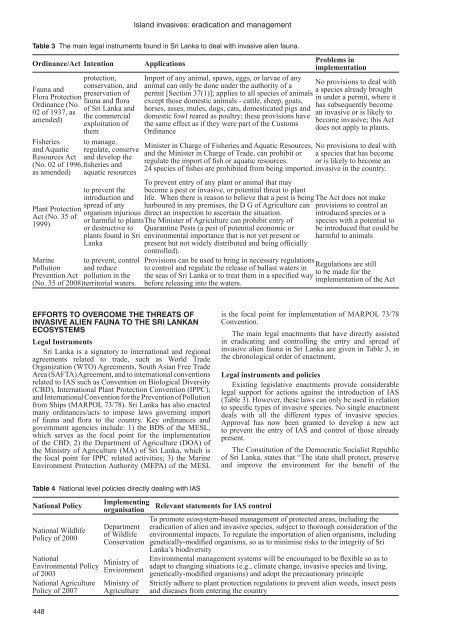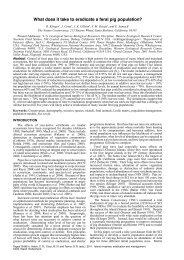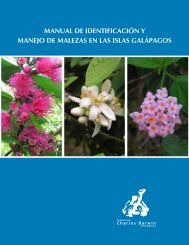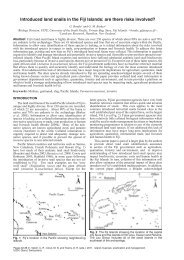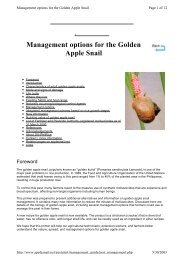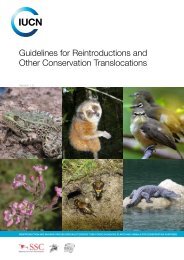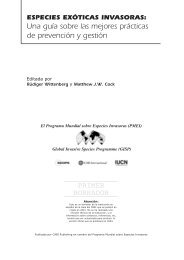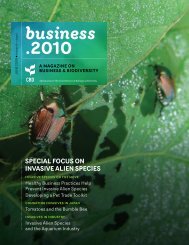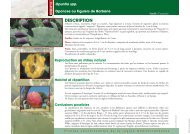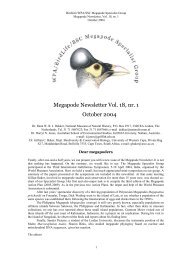Invasive alien fauna in Sri Lanka: National list, impacts and ...
Invasive alien fauna in Sri Lanka: National list, impacts and ...
Invasive alien fauna in Sri Lanka: National list, impacts and ...
Create successful ePaper yourself
Turn your PDF publications into a flip-book with our unique Google optimized e-Paper software.
Isl<strong>and</strong> <strong>in</strong>vasives: eradication <strong>and</strong> management<br />
Table 3 The ma<strong>in</strong> legal <strong>in</strong>struments found <strong>in</strong> <strong>Sri</strong> <strong>Lanka</strong> to deal with <strong>in</strong>vasive <strong>alien</strong> <strong>fauna</strong>.<br />
Ord<strong>in</strong>ance/Act Intention<br />
protection,<br />
Fauna <strong>and</strong><br />
conservation, <strong>and</strong><br />
Flora Protection<br />
preservation of<br />
Ord<strong>in</strong>ance (No.<br />
<strong>fauna</strong> <strong>and</strong> flora<br />
02 of 1937, as<br />
of <strong>Sri</strong> <strong>Lanka</strong> <strong>and</strong><br />
amended)<br />
the commercial<br />
exploitation of<br />
them<br />
Fisheries<br />
<strong>and</strong> Aquatic<br />
Resources Act<br />
(No. 02 of 1996,<br />
as amended)<br />
Plant Protection<br />
Act (No. 35 of<br />
1999)<br />
Mar<strong>in</strong>e<br />
Pollution<br />
Prevention Act<br />
(No. 35 of 2008)<br />
to manage,<br />
regulate, conserve<br />
<strong>and</strong> develop the<br />
fisheries <strong>and</strong><br />
aquatic resources<br />
to prevent the<br />
<strong>in</strong>troduction <strong>and</strong><br />
spread of any<br />
organism <strong>in</strong>jurious<br />
or harmful to plants<br />
or destructive to<br />
plants found <strong>in</strong> <strong>Sri</strong><br />
<strong>Lanka</strong><br />
to prevent, control<br />
<strong>and</strong> reduce<br />
pollution <strong>in</strong> the<br />
territorial waters.<br />
Applications<br />
Problems <strong>in</strong><br />
implementation<br />
Import of any animal, spawn, eggs, or larvae of any<br />
animal can only be done under the authority of a<br />
No provisions to deal with<br />
permit [Section 37(1)]; applies to all species of animals<br />
a species already brought<br />
except those domestic animals - cattle, sheep, goats,<br />
<strong>in</strong> under a permit, where it<br />
horses, asses, mules, dogs, cats, domesticated pigs <strong>and</strong><br />
has subsequently become<br />
domestic fowl reared as poultry; these provisions have<br />
an <strong>in</strong>vasive or is likely to<br />
the same effect as if they were part of the Customs<br />
become <strong>in</strong>vasive; this Act<br />
Ord<strong>in</strong>ance<br />
does not apply to plants.<br />
M<strong>in</strong>ister <strong>in</strong> Charge of Fisheries <strong>and</strong> Aquatic Resources,<br />
<strong>and</strong> the M<strong>in</strong>ister <strong>in</strong> Charge of Trade, can prohibit or<br />
regulate the import of fish or aquatic resources.<br />
24 species of fishes are prohibited from be<strong>in</strong>g imported.<br />
To prevent entry of any plant or animal that may<br />
become a pest or <strong>in</strong>vasive, or potential threat to plant<br />
life. When there is reason to believe that a pest is be<strong>in</strong>g<br />
harboured <strong>in</strong> any premises, the D G of Agriculture can<br />
direct an <strong>in</strong>spection to ascerta<strong>in</strong> the situation.<br />
The M<strong>in</strong>ister of Agriculture can prohibit entry of<br />
Quarant<strong>in</strong>e Pests (a pest of potential economic or<br />
environmental importance that is not yet present or<br />
present but not widely distributed <strong>and</strong> be<strong>in</strong>g officially<br />
controlled).<br />
No provisions to deal with<br />
a species that has become<br />
or is likely to become an<br />
<strong>in</strong>vasive <strong>in</strong> the country.<br />
The Act does not make<br />
provisions to control an<br />
<strong>in</strong>troduced species or a<br />
species with a potential to<br />
be <strong>in</strong>troduced that could be<br />
harmful to animals<br />
Provisions can be used to br<strong>in</strong>g <strong>in</strong> necessary regulations<br />
to control <strong>and</strong> regulate the release of ballast waters <strong>in</strong><br />
Regulations are still<br />
the seas of <strong>Sri</strong> <strong>Lanka</strong> or to treat them <strong>in</strong> a specified way<br />
to be made for the<br />
before releas<strong>in</strong>g <strong>in</strong>to the waters.<br />
implementation of the Act<br />
EFFORTS TO OVERCOME THE THREATS OF<br />
INVASIVE ALIEN FAUNA TO THE SRI LANKAN<br />
ECOSYSTEMS<br />
Legal Instruments<br />
<strong>Sri</strong> <strong>Lanka</strong> is a signatory to <strong>in</strong>ternational <strong>and</strong> regional<br />
agreements related to trade, such as World Trade<br />
Organization (WTO) Agreements, South Asian Free Trade<br />
Area (SAFTA) Agreement, <strong>and</strong> to <strong>in</strong>ternational conventions<br />
related to IAS such as Convention on Biological Diversity<br />
(CBD), International Plant Protection Convention (IPPC),<br />
<strong>and</strong> International Convention for the Prevention of Pollution<br />
from Ships (MARPOL 73/78). <strong>Sri</strong> <strong>Lanka</strong> has also enacted<br />
many ord<strong>in</strong>ances/acts to impose laws govern<strong>in</strong>g import<br />
of <strong>fauna</strong> <strong>and</strong> flora to the country. Key ord<strong>in</strong>ances <strong>and</strong><br />
government agencies <strong>in</strong>clude: 1) the BDS of the MESL,<br />
which serves as the focal po<strong>in</strong>t for the implementation<br />
of the CBD; 2) the Department of Agriculture (DOA) of<br />
the M<strong>in</strong>istry of Agriculture (MA) of <strong>Sri</strong> <strong>Lanka</strong>, which is<br />
the focal po<strong>in</strong>t for IPPC related activities; 3) the Mar<strong>in</strong>e<br />
Environment Protection Authority (MEPA) of the MESL<br />
is the focal po<strong>in</strong>t for implementation of MARPOL 73/78<br />
Convention.<br />
The ma<strong>in</strong> legal enactments that have directly assisted<br />
<strong>in</strong> eradicat<strong>in</strong>g <strong>and</strong> controll<strong>in</strong>g the entry <strong>and</strong> spread of<br />
<strong>in</strong>vasive <strong>alien</strong> <strong>fauna</strong> <strong>in</strong> <strong>Sri</strong> <strong>Lanka</strong> are given <strong>in</strong> Table 3, <strong>in</strong><br />
the chronological order of enactment.<br />
Legal <strong>in</strong>struments <strong>and</strong> policies<br />
Exist<strong>in</strong>g legislative enactments provide considerable<br />
legal support for actions aga<strong>in</strong>st the <strong>in</strong>troduction of IAS<br />
(Table 3). However, these laws can only be used <strong>in</strong> relation<br />
to specific types of <strong>in</strong>vasive species. No s<strong>in</strong>gle enactment<br />
deals with all the different types of <strong>in</strong>vasive species.<br />
Approval has now been granted to develop a new act<br />
to prevent the entry of IAS <strong>and</strong> control of those already<br />
present.<br />
The Constitution of the Democratic Socia<strong>list</strong> Republic<br />
of <strong>Sri</strong> <strong>Lanka</strong>, states that “The state shall protect, preserve<br />
<strong>and</strong> improve the environment for the benefit of the<br />
Table 4 <strong>National</strong> level policies directly deal<strong>in</strong>g with IAS<br />
<strong>National</strong> Policy<br />
<strong>National</strong> Wildlife<br />
Policy of 2000<br />
<strong>National</strong><br />
Environmental Policy<br />
of 2003<br />
<strong>National</strong> Agriculture<br />
Policy of 2007<br />
Implement<strong>in</strong>g<br />
organisation<br />
Department<br />
of Wildlife<br />
Conservation<br />
M<strong>in</strong>istry of<br />
Environment<br />
M<strong>in</strong>istry of<br />
Agriculture<br />
Relevant statements for IAS control<br />
To promote ecosystem-based management of protected areas, <strong>in</strong>clud<strong>in</strong>g the<br />
eradication of <strong>alien</strong> <strong>and</strong> <strong>in</strong>vasive species, subject to thorough consideration of the<br />
environmental <strong>impacts</strong>. To regulate the importation of <strong>alien</strong> organisms, <strong>in</strong>clud<strong>in</strong>g<br />
genetically-modified organisms, so as to m<strong>in</strong>imise risks to the <strong>in</strong>tegrity of <strong>Sri</strong><br />
<strong>Lanka</strong>’s biodiversity<br />
Environmental management systems will be encouraged to be flexible so as to<br />
adapt to chang<strong>in</strong>g situations (e.g., climate change, <strong>in</strong>vasive species <strong>and</strong> liv<strong>in</strong>g,<br />
genetically-modified organisms) <strong>and</strong> adopt the precautionary pr<strong>in</strong>ciple<br />
Strictly adhere to plant protection regulations to prevent <strong>alien</strong> weeds, <strong>in</strong>sect pests<br />
<strong>and</strong> diseases from enter<strong>in</strong>g the country<br />
448


